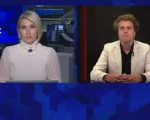
March’s robust job gains may push the Federal Reserve into a more cautious stance regarding potential rate cuts, with conflicting signs emerging about the labor market’s strength. After the Labor Department’s nonfarm payrolls report Friday showed a robust gain of 303,000, futures market pricing indicated barely more than 50% of a chance that the Fed will start cutting in June. A strong jobs outlook raises the potential of greater inflation pressures, meaning the central bank might be less eager to ease policy. In recent days, the potential of a tighter Fed has been poison for stocks, though they staged a solid relief rally Friday despite the strong payrolls data. “Another massive jobs number is making Fed rate cut forecasters hot under the collar,” said Seema Shah, chief global strategist at Principal Asset Management. Looking at the bright side, though, Shah added that “[Friday’s] report should reassure markets that, if the Fed does not cut in June, it’s because the economy is still strong and earnings should remain in an upswing.” Signs of weakness The jobs numbers indicate a tight labor market and an economy remaining strong despite the Fed holding its benchmark short-term borrowing rate at its highest level in 23 years. Some investors and economists, though, still worry that the Fed might be restrictive for too long. Mohamed El-Erian, the chief economic advisor at Allianz, charged Friday that the Fed has become too reliant on rolling data points and instead should focus on longer-term strategy. “The mistake that they may make is they’ll end up this time being too tight,” he told CNBC during a financial conference in Italy. Indeed, there are some signs that the labor market’s strength may not be as robust as the headline nonfarm payrolls numbers indicate. For one, while the payrolls numbers reflect the total jobs gained through the wide-ranging survey of establishments, the narrower household survey has consistently shown fewer people actually working. Though the latter count indicated an uptick of 498,000 in March, the number of employed people is down by about 400,000 since November. There’s also the compositional aspect of employment. Much of the job gains over the past several months have come from just a few sectors: health care, government and leisure and hospitality, though March showed a solid gain in construction. Then there’s the concentration of gains toward part-time rather than full-time employment. The number of workers who report holding jobs full time fell by 6,000 in March and is down a whopping 1.35 million from a year ago. At the same time, the rolls of part-time workers swelled by 691,000 in March and are up 1.9 million, or 7%, from a year ago. In addition, there’s the level of those reporting that they have lost their jobs permanently, a number that has soared by more than 30% since January 2023 though it declined in March. Temp jobs , which many economists look to for signs of a flagging employment market, also nudged lower again in March and are down by 181,000 from a year ago, a decline of 6.2%. The role of immigration So what’s keeping the headline numbers so high? Economists both on Wall Street and at the Fed suspect swelling immigration numbers are playing a role in boosting employment and keeping the labor market so tight. Goldman Sachs, citing data from the Congressional Budget Office and other sources, estimates 2.5 million immigrants crossed the U.S. borders in 2023, the highest level in more than two decades, with “unauthorized immigrants from South America, Central America, and Mexico” accounting for “most of the recent surge.” Fed Governor Michelle Bowman on Friday noted the gains in part-time employment over the past year and said “some of the recent strength in job gains may reflect stronger labor supply due to increased immigration.” Bowman warned that the Fed may have to hike again in the future if inflation proves stubborn. With political clamoring intensifying for the U.S. to tighten its border controls, the resilience of the labor market then could be jeopardized depending on how large a role immigration is playing. Citigroup has a Fed call, well out of Wall Street consensus, for rate cuts of 125 basis points, or 1.25 percentage points, this year, based in large part on potential labor market deterioration. Futures markets are pricing in three cuts totaling 75 basis points, matching the unofficial estimate Fed officials released in March. A basis point is one-hundredth of a percentage point. “Another strong report raises the potential that the deterioration in labor markets we have been expecting will be avoided. But we still see enough weakness in the household survey and elsewhere to leave our base case for a more significant uptick in unemployment later this year,” Citi economist Andrew Hollenhorst said in a client note. “Usually much-stronger-than-expected job growth would provoke more hawkish (or at least less dovish) Fed policy,” he added. “But that is not currently the case. In part that is because Fed officials are recognizing the same signs of downside risk to future jobs readings as we are.”






